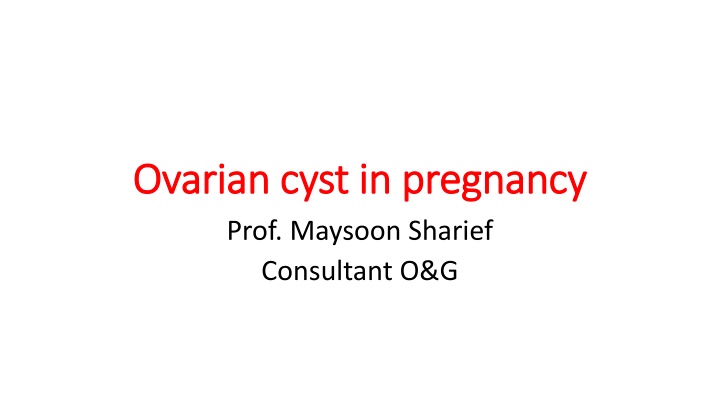
Role of History and Examination in Evaluating Ovarian Masses
Learn about the importance of history and examination in assessing women with ovarian masses, recommended blood tests, the role of ultrasound, and methods for estimating the risk of malignancy. Understand the significance of differentiating between benign and malignant ovarian masses through various diagnostic approaches.
Download Presentation

Please find below an Image/Link to download the presentation.
The content on the website is provided AS IS for your information and personal use only. It may not be sold, licensed, or shared on other websites without obtaining consent from the author. If you encounter any issues during the download, it is possible that the publisher has removed the file from their server.
You are allowed to download the files provided on this website for personal or commercial use, subject to the condition that they are used lawfully. All files are the property of their respective owners.
The content on the website is provided AS IS for your information and personal use only. It may not be sold, licensed, or shared on other websites without obtaining consent from the author.
E N D
Presentation Transcript
Ovarian cyst in pregnancy Ovarian cyst in pregnancy Prof. Maysoon Sharief Consultant O&G
Types of adnexal masses 1- Benign ovarian Functional cysts Endometriomas Serous cystadenoma Mucinous cystadenoma Mature teratoma Benign 2-non-ovarian Paratubal cyst 2- Hydrosalpinges Tubo-ovarian abscess Peritoneal pseudocysts Appendiceal abscess Diverticular abscess Pelvic kidney 3-Benign ovarian tumour 4- Primary malignant ovarian Germ cell tumour Epithelial carcinoma Sex-cord tumour 5-Secondary malignant ovarian Predominantly breast and gastrointestinal carcinoma
What is the role of history and examination in the assessment of What is the role of history and examination in the assessment of women with suspected ovarian masses? women with suspected ovarian masses?
What blood tests should be performed? What blood tests should be performed? A serum CA-125 assay does not need to be undertaken in all premenopausal women when an ultrasonographic diagnosis of a simple ovarian cyst has been made Lactate dehydrogenase (LDH), -FP and hCG should be measured in all women under age 40 with a complex ovarian mass because of the possibility of germ cell tumours. A serum CA-125 assay is not necessary when a clear ultrasonographic diagnosis of a simple ovarian cyst has been made 1- If a serum CA-125 assay is raised and less than 200 units/ml, further investigation may be appropriate to exclude/treat the common differential diagnoses When serum CA-125 levels are raised, serial monitoring of CA-125 may be helpful as rapidly rising levels are more likely to be associated with malignancy than high levels which remain static. If serum CA-125 assay more than 200 units/ml, discussion with a gynaecological oncologist is recommended.
What is the role of ultrasound in the assessment of suspected What is the role of ultrasound in the assessment of suspected ovarian masses? ovarian masses? What is the role of the routine use of computed tomography and magnetic resonance imaging (MRI) in the assessment of suspected ovarian masses? What is the best way to estimate the risk of malignancy? An estimation of the risk of malignancy is essential in the assessment of an ovarian mass. At present the Risk of Malignancy Index (RMI) is the most widely used model but recent studies have shown a specific model of ultrasound parameters, the ultrasound rules derived from the International Ovarian Tumor Analysis (IOTA) Group, to have increased sensitivity and specificity
Calculation of the RMI Calculation of the RMI I RMI I combines three presurgical features: The RMI is a product of the ultrasound scan score, the menopausal status and the serum CA-125 level (IU/ml) 1-serum CA-125 (CA-125); 2- menopausal status (M); as follows The menopausal status is scored as 1 = premenopausal and 3 = postmenopausal. Postmenopausal can be defined as women who have had no period for more than one year or women over the age of 50 who have had a hysterectomy. 3-ultrasound score (U) The ultrasound result is scored 1 point for each of the following characteristics: multilocular cysts, solid areas, metastases, ascites and bilateral lesions . :
RMI = U x M x CA RMI = U x M x CA- -125 125. .
